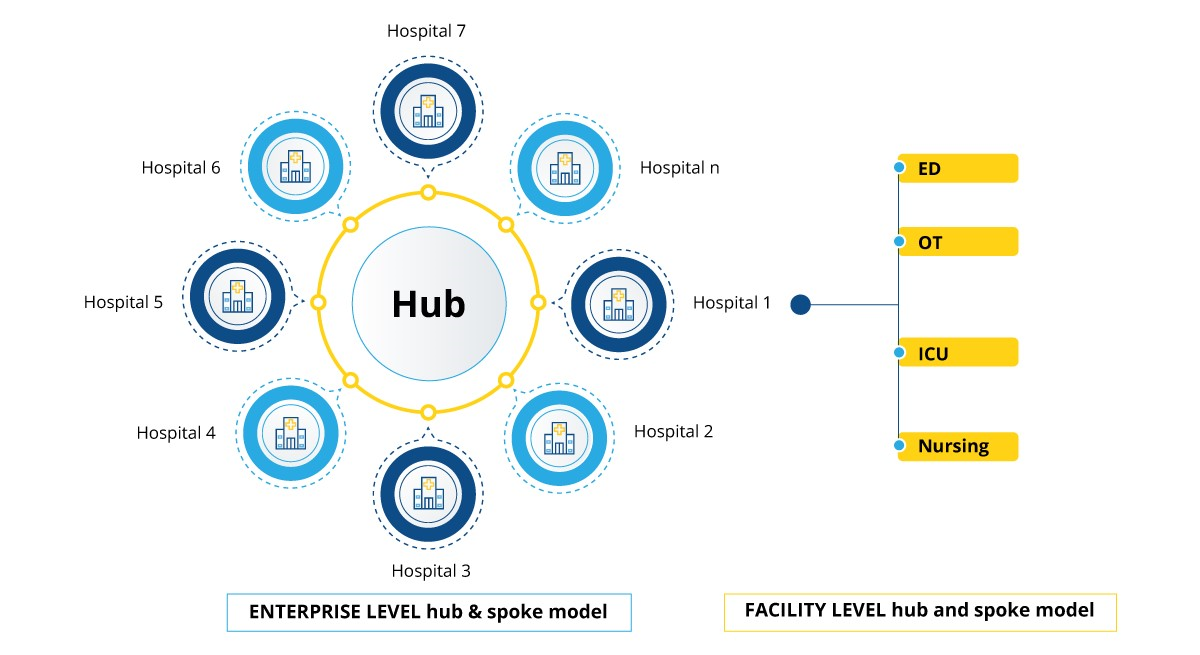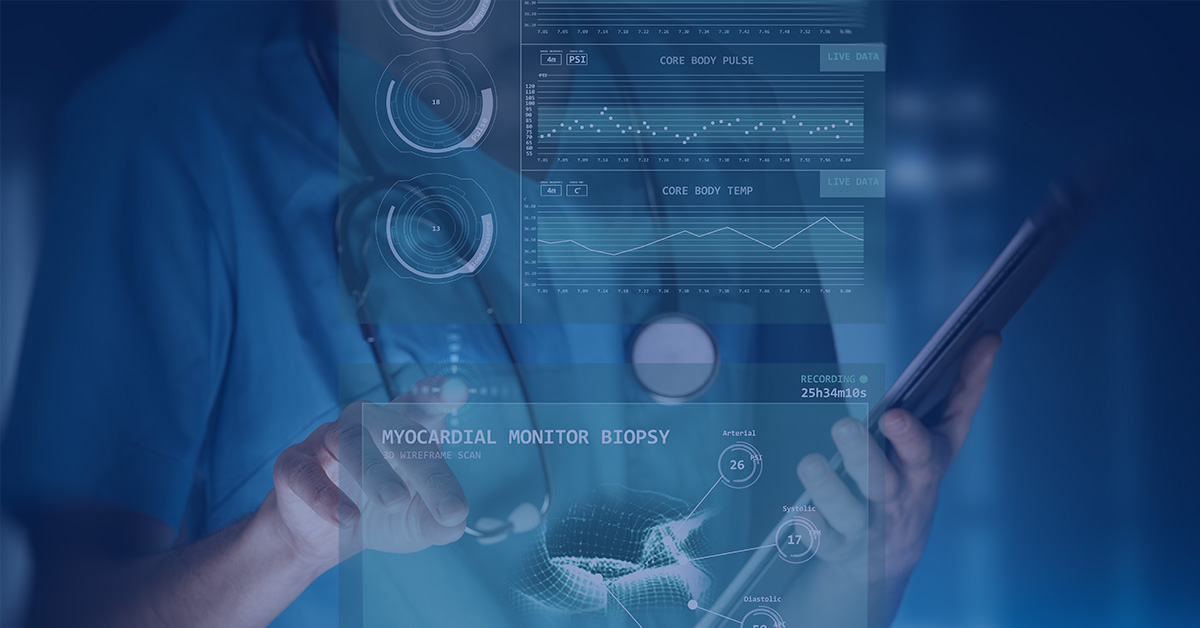Imagine a situation where a cardiac patient is about to have a heart attack and their wearable device alerts the hospital of abnormal heart rate and oxygen saturation; the hospital is able to connect with the patient proactively to assess the situation and dispatch an ambulance, access the patient’s medical data in parallel and prepare the ED for prompt attention on arrival.
Imagine another situation where a hospital under Code Red, has immediate access to holistic and real-time view of hospital operations for enabling centralized communication, facilitating alert distribution, and coordinating among response teams, supplies tracking and patients for evacuation.

The above situations are fast becoming a reality with integrated hospital command and control centers (HCCC). A HCCC helps centrally manage hospital operations and elevates the coverage, speed, and efficacy of responding to medical situations – boosting outcomes, efficiencies, experiences, as well as mitigating financial risks, through connected ecosystems, prompt interdisciplinary collaboration, and data-backed action.
In this blog, part 2 in the “Hospital of the Future” series, we explore the concept of integrated command-and-control centers in healthcare, a relatively modern development that has gained traction and maturity over the past few years. The HCCC is enabling healthcare providers worldwide to transition from reactive to proactive. Initially inspired by the command centers used in sectors like the military, police, aviation, smart cities, etc., the healthcare sector is recognizing the potential to advance the triple aim of healthcare by leveraging technology advancements as an enabler.
Streamlining Operations
By tracking bed availability, staff assignments, medical equipment and supplies distribution, hospitals can optimize their resources by predicting their needs and filling gaps. This ensures that patients receive the right care at the right time.
During external emergencies like outbreaks, natural disasters, or mass casualty incidents, the HCCC becomes the nerve center for coordinating responses, allocating supplies, and managing patient transfers. By analyzing incoming patient data and demand patterns, these centers can efficiently allocate staff, equipment, and facilities.
In internal emergencies, including a code red, code black, code white or code amber, the HCCC helps to plan threat isolation, facility evacuation, lost person tracking, and serves as the source of data to review the facility’s response and identify areas of improvement to incorporate learnings into future planning.
In terms of promoting environmental sustainability within healthcare facilities, HCCC can track energy utilization, water consumption, biomedical waste disposal, recycling programs, green building performance, carbon footprint, or indoor air quality to identify scope of efficiency improvement.
Shaping Quality Outcomes
By monitoring patient data, both in-facility or remotely, healthcare providers can swiftly be alerted of any early warning signs of patient deterioration, thus instrumenting early intervention leading to reduced morbidity and mortality.
Moreover, quality measures / KPIs to monitor patient safety, infection control, readmission rate, mortality, length of hospital stays, patient-satisfaction or population level clinical outcomes can be configured as per need from time to time. Simple and interactive views of such complex and diverse measures help identify areas of improvement, enforce evidence-backed practices, and ultimately drives incremental improvements in the care quality provided to patients, or even qualify for related incentives.
The resulting streamlined hospital workflows, adherence to best practices and care coordination, therefore, helps shape hospital care management.
Empowering Caregivers & Patients with Enhanced Experiences
For caregivers, HCCC’s help relieve physicians and nurses of administrative tasks and allow them to focus more on clinical tasks, reducing burnout and improving care efficiency.
By ensuring personalized care, prompt assistance, coordinated discharge, appointment reminders, the command centers also serve as dependable healthcare partners for patients, enhancing their overall healthcare experience, and reducing anxiety that arises around stressful hospital environments.
Hub-and-spoke model

In the healthcare sector, since every specialty has its own expertise and parameters that might require direct attention, a hub and spoke model of the HCCC serves to drive a more decentralized approach.
A central hub manages operations across different levels of care, multiple facilities, or various units within a hospital or healthcare network, while the spokes operate somewhat autonomously while remaining connected to the central hub for coordination and communication.
Such hierarchal arrangements of control allow the complex healthcare ecosystem to be adaptive to changing patient load and external dynamics by balancing resources between underutilized and overwhelmed spokes.
Hybrid CCC
With cloud and SaaS as enablers, a hybrid command center gives the flexibility of remote operations while still having a physical center, thus enabling access to the command center even in times of natural disaster or severe weather conditions
Command centers rely on an array of technologies like health information systems, interoperability, analytics, GIS, cloud computing, and mobile apps for their seamless functioning. Together, these technologies facilitate real-time monitoring, data analysis, communication, and decision-making to improve healthcare delivery and response capabilities.
Standardized healthcare data exchange protocols like FHIR, HL7, DICOM allow for a seamless and secure exchange of data between different systems. Real-time data sharing ensures that resources are deployed efficiently, and critical information is disseminated to the right stakeholders. This rapid response capability is essential for saving lives and minimizing the impact of emergencies.
Wearable devices and monitoring sensors provide the HCCC with real time patient data. Secure storage and retrieval of this large volume of patient data is possible by leveraging the cloud. Integration of advanced AI and automation technologies will further enhance the capabilities of the HCCC, enabling more precise predictions and faster response times.
Predictive analytics also aids in long-term planning, allowing healthcare organizations to invest in the right infrastructure and resources to meet future demands effectively.
NexGen Comms, powered by 5G connectivity, aids in ensuring near zero-time transmission of data for seamless remote monitoring and tele consults. GIS helps in optimizing ambulance routes, resource allocation during emergencies, visualizing patient location and tracking disease spread.
In the context of disease surveillance, the HCCC can monitor population health by tracking symptoms reported in real time. During an outbreak, this data can be invaluable in predicting the spread of diseases and allocating resources where they are most needed.
A virtual replica or simulation of a physical healthcare facility in the form of a digital twin serves as a dynamic, real-time model that allows healthcare administrators and staff to monitor, analyze, and optimize both the facility and patient care processes.
It may appear that a command center with many surveillance and analytic features would be the most efficient. However, it is important to note that too much noise in terms of multiple visual inputs, complicated dashboards, alerts, and alarms can cause alert fatigue or desensitization. Hence, it is important to understand how much is too much and accordingly implement intelligent filtering for triaging alerts, to make the most of the centers.
Since healthcare is a dynamic ecosystem, it must be flexible enough to manage situations like mass casualties, outbreaks, and re-prioritized national programs. Smart command centers would be adaptive to these scenarios and allow for quick configuration of newer views with minimum effort in the least amount of time.
As command centers deal with tons of data, the user interface should allow delegation of permissions to different users and roles for actions like viewing, generating alerts, sending messages for communication, and so on. Allowing flexibility to implement workflows that can be configured on-the-fly to accommodate different care pathways, departments, or specialties ensures that the system remains relevant across various healthcare scenarios.
In essence, HCCCs represent a convergence of data-driven decision-making, artificial intelligence, and real-time communication. They empower healthcare organizations to deliver better patient care, optimize operations, and respond swiftly to emergencies. The comprehensive data analysis and resource allocation capabilities of the HCCCs are the cornerstones of their success, resulting in improved patient outcomes, cost savings, and enhanced overall healthcare management.
Healthcare Command Centres are control towers that do not just aim to respond to crisis, they anticipate them and orchestrate resources to mitigate them. LTTS has expertise in implementing state-of-the-art integrated command and control centers for various sectors and smart cities globally, a deep ER&D- led technology innovation focus, robust healthcare domain knowledge and integration/interoperability experience – key ingredients for designing and implementing next-gen sustainable healthcare command and control centers.
Let’s #engineerthechange in healthcare, together!





